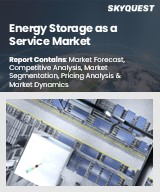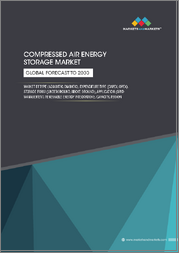
|
시장보고서
상품코드
1624248
세계의 재생 가능 에너지 시장 : 유형(수력·풍력·태양·바이오·지열·해양), 용도(가정용·산업용·상용), 지역별 예측(-2032년)Global Renewable Energy Market Research Report Information by Type (Hydropower, Wind Energy, Solar Energy, Bioenergy, Geothermal Energy and Ocean Energy) By Application (Residential, Industrial and Commercial) and By Region Forecast to 2032 |
||||||
세계 재생가능 에너지 시장 규모는 2023년 1조 929억 1,000만 달러, 2024년 1조 2,190억 달러에서 예측기간 동안 8.13%의 연평균 복합 성장률(CAGR)로 성장을 지속하여 2032년에는 2조 2,778 4,000만 달러의 규모로 성장할 것으로 예상됩니다.
재생가능 에너지 프로젝트의 초기 비용을 낮추는 재정적 인센티브는 재생가능 에너지 시장을 견인하는 가장 중요한 수단 중 하나입니다. 예를 들어, 미국의 기업이나 가정은 ITC(Federal Investment Tax Credit) 아래, 2024년에 태양광 발전 시스템 비용의 30%에 해당하는 세액 공제를 신청할 수 있습니다. 이와 마찬가지로 PTC(Production Tax Credit)는 풍력 터빈의 발전량에 따라 세금 혜택을 제공함으로써 풍력 발전 프로젝트의 성장을 가속합니다.
지역별 관점
아시아태평양의 재생가능 에너지 시장이 최대의 점유율을 차지하고 있으며, 예측기간 동안에도 상당한 수익 점유율을 창출할 것으로 예측되고 있습니다. 재생 가능 에너지 분야는 세계적으로 현저한 성장을 이루고 있습니다. 이 지역은 현재 가장 유망합니다.
이 보고서는 세계의 재생 가능 에너지 시장을 조사했으며, 시장 정의와 개요, 시장 성장에 대한 각종 영향요인 분석, 시장 규모 추이· 예측, 각종 구분· 지역/주요 국가별 분석, 경쟁 환경, 주요 기업 프로파일 등을 정리했습니다.
목차
제1장 주요 요약
제2장 시장 개요
제3장 조사 방법
제4장 시장 역학
- 개요
- 성장 촉진요인
- 정부 인센티브와 보조금
- 환경 의식 증가
- 성장 촉진요인의 영향 분석
- 억제요인
- 그리드 통합의 과제
- 억제요인의 영향 분석
- 기회
- 에너지 저장 솔루션 수요 증가
- COVID-19가 세계의 재생 가능 에너지 시장에 미치는 영향
- 공급망에 미치는 영향
제5장 시장 요인 분석
- 공급/가치 체인 분석
- Porter's Five Forces 분석
제6장 세계의 재생 가능 에너지 시장 : 유형별
제8장 세계의 재생 가능 에너지 시장 : 용도별
제10장 세계의 재생 가능 에너지 시장 : 지역별
- 개요
- 북미
- 미국
- 캐나다
- 유럽
- 독일
- 영국
- 프랑스
- 러시아
- 이탈리아
- 스페인
- 기타
- 아시아태평양
- 중국
- 인도
- 일본
- 한국
- 기타
- 라틴아메리카
- 브라질
- 멕시코
- 아르헨티나
- 기타
- 중동 및 아프리카
- GCC 국가
- 남아프리카
- 중동 및 아프리카
제11장 경쟁 구도
- 경쟁 개요
- 경쟁 벤치마킹
- 세계 주요 기업
- 개발 건수로 톱의 기업
- 주요 전개 및 성장 전략
제12장 기업 프로파일
- ABB LTD.
- XCEL ENERGY INC.
- ACCIONA
- INNERGEX
- INVENERGY
- GENERAL ELECTRIC
- TATA POWER
- SIEMENS GAMESA RENEWABLE ENERGY SA
- NATIONAL GRID RENEWABLES
- EDF RENEWABLES
제13장 부록
JHS 25.01.22Overview of the Market
In 2023, the market for renewable energy was estimated to be worth USD 1,092.91 billion. With a compound annual growth rate (CAGR) of 8.13% from 2024 to 2032, the Renewable Energy Market is expected to increase from USD 1,219.00 billion in 2024 to USD 2,277.84 billion by 2032. Energy from natural resources that are continuously and naturally renewed on a human timeline is referred to as renewable energy. Renewable energy sources include solar, wind, hydropower, geothermal, and biomass, in contrast to fossil fuels, which are limited and release greenhouse gases into the atmosphere.
Financial incentives that lower the initial costs of renewable energy projects are one of the most important ways that the Renewable Energy Market is driven by the expanding government subsidies and incentives. For instance, businesses and families in the US can claim a tax credit equal to 30% of the cost of their solar systems in 2024 under the Federal Investment Tax Credit (ITC). A wider spectrum of households and businesses may now afford solar installations because to this significant financial gain, which also decreases the initial expenditure needed. Like this, the Production Tax Credit (PTC) promotes the growth of wind power projects by providing tax advantages based on the quantity of energy generated by wind turbines. These incentives increase the appeal and viability of investments in renewable energy, which speeds up market expansion.
Perspectives on Market Segments
Hydropower, wind, solar, bioenergy, geothermal, and ocean energy are the several types of renewable energy that make up the market.
The market is divided into three segments based on application: residential, industrial, and commercial.
Regional Perspectives
The market for renewable energy is divided into the following regions: North America, Europe, Asia Pacific, South America, the Middle East, and Africa. The market for renewable energy in Asia Pacific has the largest market share and is anticipated to generate a sizable revenue share over the course of the projected period. With the anticipation that global consumption of renewable energy will continue to rise, the renewable energy sector has seen tremendous growth on a global scale. This is probably an attempt to counteract over dependence on non-renewable energy sources. Although half of the world's population lives in the Asia-Pacific area, its reliance on fossil fuels is also debatable. When compared to North America and Europe, the region is currently the most promising because it is expanding much-needed investments in the production of renewable energy.
Despite these efforts, the Asia-Pacific region faces numerous obstacles related to renewable energy infrastructures. The high expenses and requirements for quality land and facilities for renewable energy projects are some of the main ones. In spite of these realities, nearly every nation in this region has built some sort of renewable energy infrastructure. People in many Asian-Pacific nations believe that their solar and wind energy systems are excellent. As a result, it is not surprising that the Asia-Pacific region is home to several of the world's top leaders in the field of renewable energy.
Key Players
ABB, Xcel Energy Inc., Acciona, Innergex, Invenergy, General Electric, Tata Power, Siemens Gamesa Renewable Energy SA, National Grid Renewables, and EDF Renewables are some of the major companies in the renewable energy market.
TABLE OF CONTENTS
1 EXECUTIVE SUMMARY
- 1.1 GLOBAL RENEWABLE ENERGY MARKET, BY TYPE
- 1.3 GLOBAL RENEWABLE ENERGY MARKET, BY APPLICATION
- 1.5 GLOBAL RENEWABLE ENERGY MARKET, BY REGION
2 MARKET INTRODUCTION
- 2.1 DEFINITION
- 2.2 SCOPE OF THE STUDY
- 2.3 MARKET STRUCTURE
- 2.4 KEY BUYING CRITERIA
3 RESEARCH METHODOLOGY
- 3.1 RESEARCH PROCESS
- 3.2 PRIMARY RESEARCH
- 3.3 SECONDARY RESEARCH
- 3.4 MARKET SIZE ESTIMATION
- 3.5 TOP DOWN & BOTTOM-UP APPROACH
- 3.6 FORECAST MODEL
- 3.7 LIST OF ASSUMPTIONS
4 MARKET DYNAMICS
- 4.1 INTRODUCTION
- 4.2 DRIVERS
- 4.2.1 GOVERNMENT INCENTIVES AND SUBSIDIES
- 4.2.2 GROWING ENVIRONMENTAL AWARENESS
- 4.2.3 DRIVERS IMPACT ANALYSIS
- 4.3 RESTRAINTS
- 4.3.1 GRID INTEGRATION CHALLENGES
- 4.3.2 RESTRAINTS IMPACT ANALYSIS
- 4.4 OPPORTUNITIES
- 4.4.1 INCREASING DEMAND FOR ENERGY STORAGE SOLUTIONS
- 4.5 IMPACT OF COVID-19 ON GLOBAL RENEWABLE ENERGY MARKET
- 4.6 IMPACT OF COVID-19 ON THE GLOBAL RENEWABLE ENERGY MARKET
- 4.7 SUPPLY CHAIN IMPACT
- 4.7.1 IMPACT ON MANUFACTURER/DEVELOPER
- 4.7.2 IMPACT ON COMPONENT/SERVICES SUPPLIER
- 4.7.3 IMPACT ON DISTRIBUTION/LOGISTICS
5 MARKET FACTOR ANALYSIS
- 5.1 SUPPLY/VALUE CHAIN ANALYSIS
- 5.1.1 RAW MATERIALS AND COMPONENTS SUPPLIERS
- 5.1.2 MANUFACTURING & ASSEMBLY
- 5.1.3 DISTRIBUTION & SALES
- 5.1.4 RETAILERS AND APPLICATION
- 5.2 PORTER'S FIVE FORCES MODEL
- 5.2.1 THREAT OF NEW ENTRANTS
- 5.2.2 BARGAINING POWER OF SUPPLIERS
- 5.2.3 BARGAINING POWER OF BUYERS
- 5.2.4 THREAT OF SUBSTITUTES
- 5.2.5 INTENSITY OF RIVALRY
6 GLOBAL RENEWABLE ENERGY MARKET, BY TYPE
- 6.1 OVERVIEW
- 6.2 GLOBAL RENEWABLE ENERGY MARKET SIZE, MARKET ESTIMATES & FORECAST BY TYPE, 2018-2032
- 6.2.1 GLOBAL RENEWABLE ENERGY MARKET SIZE: MARKET ESTIMATES & FORECAST BY TYPE, 2018-2032
8 GLOBAL RENEWABLE ENERGY MARKET, BY APPLICATION
- 8.1 OVERVIEW
- 8.2 GLOBAL RENEWABLE ENERGY MARKET SIZE, MARKET ESTIMATES & FORECAST BY APPLICATION, 2018-2032
- 8.2.1 GLOBAL RENEWABLE ENERGY MARKET SIZE: MARKET ESTIMATES & FORECAST BY APPLICATION, 2018-2032
10 GLOBAL RENEWABLE ENERGY MARKET, BY REGION
- 10.1 OVERVIEW
- 10.2 NORTH AMERICA
- 10.2.1 U.S.
- 10.2.2 CANADA
- 10.3 EUROPE
- 10.3.1 GERMANY
- 10.3.2 UK
- 10.3.3 FRANCE
- 10.3.4 RUSSIA
- 10.3.5 ITALY
- 10.3.6 SPAIN
- 10.3.7 REST OF EUROPE
- 10.4 ASIA PACIFIC
- 10.4.1 CHINA
- 10.4.2 INDIA
- 10.4.3 JAPAN
- 10.4.4 SOUTH KOREA
- 10.4.5 REST OF ASIA PACIFIC
- 10.5 LATIN AMERICA
- 10.5.1 BRAZIL
- 10.5.2 MEXICO
- 10.5.3 ARGENTINA
- 10.5.4 REST OF LATIN AMERICA
- 10.6 MIDDLE EAST & AFRICA
- 10.6.1 GCC COUNTRIES
- 10.6.2 SOUTH AFRICA
- 10.6.3 REST OF THE MIDDLE EAST & AFRICA
11 COMPETITIVE LANDSCAPE
- 11.1 COMPETITIVE OVERVIEW
- 11.2 COMPETITIVE BENCHMARKING
- 11.3 MAJOR PLAYERS IN THE GLOBAL RENEWABLE ENERGY MARKET
- 11.4 LEADING PLAYERS IN TERMS OF THE NUMBER OF DEVELOPMENTS IN THE GLOBAL RENEWABLE ENERGY MARKET
- 11.5 KEY DEVELOPMENTS & GROWTH STRATEGIES
- 11.5.1 PRODUCT LAUNCH/PRODUCT DEVELOPMENT/APPROVAL
- 11.5.2 ACQUISITION/PARTNERSHIP
12 COMPANY PROFILES
- 12.1 ABB LTD.
- 12.1.1 COMPANY OVERVIEW
- 12.1.2 FINANCIAL OVERVIEW
- 12.1.3 PRODUCTS OFFERED
- 12.1.4 KEY DEVELOPMENTS
- 12.1.5 SWOT ANALYSIS
- 12.1.6 KEY STRATEGIES
- 12.2 XCEL ENERGY INC.
- 12.2.1 COMPANY OVERVIEW
- 12.2.2 FINANCIAL OVERVIEW
- 12.2.3 PRODUCTS OFFERED
- 12.2.4 KEY DEVELOPMENTS
- 12.2.5 SWOT ANALYSIS
- 12.2.6 KEY STRATEGIES
- 12.3 ACCIONA
- 12.3.1 COMPANY OVERVIEW
- 12.3.2 FINANCIAL OVERVIEW
- 12.3.3 PRODUCTS OFFERED
- 12.3.4 KEY DEVELOPMENTS
- 12.3.5 SWOT ANALYSIS
- 12.3.6 KEY STRATEGIES
- 12.4 INNERGEX
- 12.4.1 COMPANY OVERVIEW
- 12.4.2 FINANCIAL OVERVIEW
- 12.4.3 PRODUCTS/SERVICES OFFERED
- 12.4.4 KEY DEVELOPMENTS
- 12.4.5 SWOT ANALYSIS
- 12.4.6 KEY STRATEGIES
- 12.5 INVENERGY
- 12.5.1 COMPANY OVERVIEW
- 12.5.2 FINANCIAL OVERVIEW
- 12.5.3 PRODUCTS/SERVICES OFFERED
- 12.5.4 KEY DEVELOPMENTS
- 12.5.5 SWOT ANALYSIS
- 12.5.6 KEY STRATEGIES
- 12.6 GENERAL ELECTRIC
- 12.6.1 COMPANY OVERVIEW
- 12.6.2 FINANCIAL OVERVIEW
- 12.6.3 PRODUCTS/SERVICES OFFERED
- 12.6.4 KEY DEVELOPMENTS
- 12.6.5 SWOT ANALYSIS
- 12.6.6 KEY STRATEGIES
- 12.7 TATA POWER
- 12.7.1 COMPANY OVERVIEW
- 12.7.2 FINANCIAL OVERVIEW
- 12.7.3 PRODUCTS/SERVICES OFFERED
- 12.7.4 KEY DEVELOPMENTS
- 12.7.5 SWOT ANALYSIS
- 12.7.6 KEY STRATEGIES
- 12.8 SIEMENS GAMESA RENEWABLE ENERGY SA
- 12.8.1 COMPANY OVERVIEW
- 12.8.2 FINANCIAL OVERVIEW
- 12.8.3 PRODUCTS OFFERED
- 12.8.4 KEY DEVELOPMENTS
- 12.8.5 SWOT ANALYSIS
- 12.8.6 KEY STRATEGIES
- 12.9 NATIONAL GRID RENEWABLES
- 12.9.1 COMPANY OVERVIEW
- 12.9.2 FINANCIAL OVERVIEW
- 12.9.3 PRODUCTS OFFERED
- 12.9.4 KEY DEVELOPMENTS
- 12.9.5 SWOT ANALYSIS
- 12.9.6 KEY STRATEGIES
- 12.10 EDF RENEWABLES
- 12.10.1 COMPANY OVERVIEW
- 12.10.2 FINANCIAL OVERVIEW
- 12.10.3 PRODUCTS OFFERED
- 12.10.4 KEY DEVELOPMENTS
- 12.10.5 SWOT ANALYSIS
- 12.10.6 KEY STRATEGIES
13 APPENDIX
- 13.1 REFERENCES



















